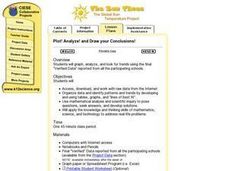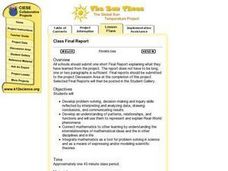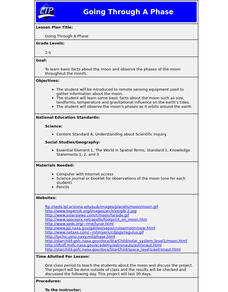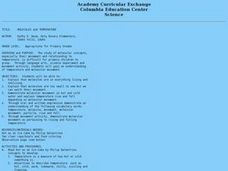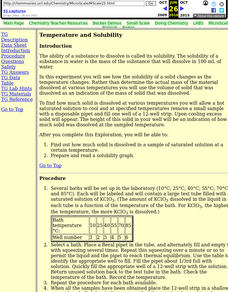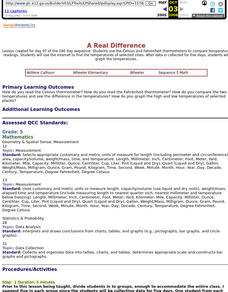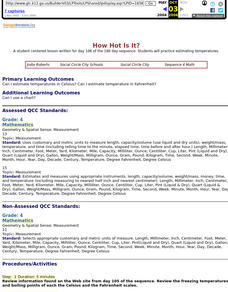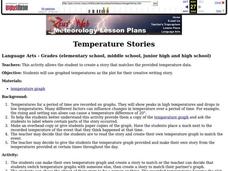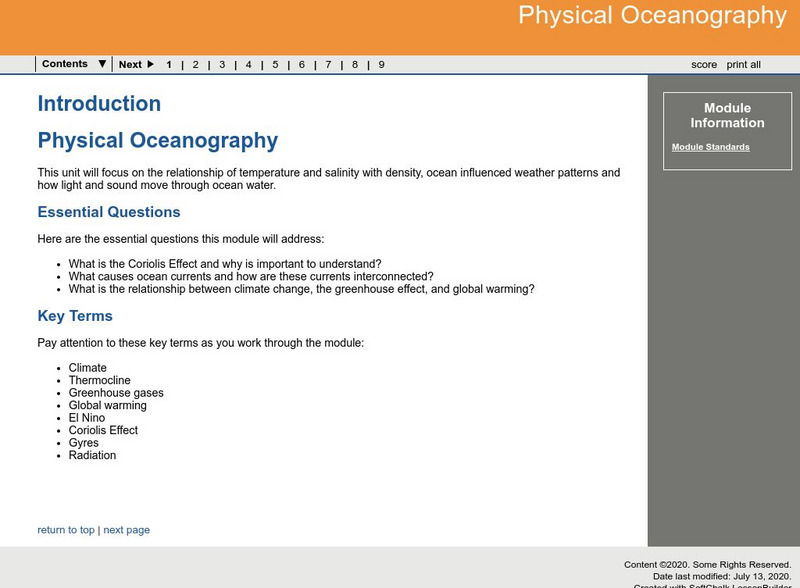Curated OER
DOES A FLUCTUATION IN TEMPERATURE IFFECT THE GROWTH AND SURVIVAL RATE OF AQUATIC PLANTS?
Students determine if different temperatures effect the growth and survival rates of aquatic plants and evaluate the optimal temperature for the growth of aquatic plants.
Curated OER
The Accuracy of Climate Data
Students use maps to determine how accurate climate data really is. They also answer questions using a table of data.
Curated OER
Sky Watching
Students trace how weather patterns generally move from west to east in the United States.
Curated OER
Fahrenheit vs Celsius
Students make a thermometer and write a paragraph about how they did it.
Curated OER
Measurement
First graders participate in various activities dealing with measurement, length, volume, and temperature. They identify the need for standard units of measure, sort and classify objects, measure distances, and use a thermometer.
Curated OER
Plot! Analyze! Draw your Conclusions!
Students download data reported from the Global Sun Temperature Project website. They graph and analyze the data looking for trends and patterns. They prepare a class report with their observations and post it to the website.
Curated OER
Class Final Report - Global Sun Temperature Project
Students reflect on the data they have analyzed during the Global Sun Temperature Project. They use the project website as a resource for their observations, draft a class report and post it on the Internet.
Curated OER
C. B. Atlas Animations: Temperature Experiments
Students investigate cooling rates of shallow and deep water, analyze Chesapeake Bay temperature information, and interpret effects of temperature variations on living organisms.
Curated OER
Going Through A Phase
Students are introduced to remote sensing equipment used to gather information about the moon. They learn basic facts about the moon such as size, landforms, temperature and gravitational influence on the earth's tides.
Curated OER
Molecules And Temperature
Students explain that molecules are in everything living and nonliving. They explain that molecules are too small to see but we can watch their movement.
Curated OER
Temperature Changes Everything
Students determine the effect of temperature on the motion of particles.
Curated OER
Taking In The Heat
Pupils discover that different textured materials can absorb more heat than others. Students work with thermometers, clocks, and graphs.
Curated OER
Temperature and Solubility
Learners experiment to see how the solubility of a solid changes as water temperature changes. They graph the results of the solubility tests.
Curated OER
A Real Difference
Fifth graders use the Celsius and Fahrenheit thermometers to compare temperature readings. They use the Internet to find the temperatures of selected cities. After data is collected for five days, 5th graders graph the temperatures.
Curated OER
Specific Heat and Insulation - Temperature Changes
Learners expand their knowledge of how temperature changes between air and soil. They also examine how natural grass cover insulates the effects of the sun's direct radiation.
Curated OER
How Hot Is It?
Fourth graders practice estimating temperatures. They practice in Celsius and Fahrenheit.
Curated OER
Temperature Stories
Students create a story that matches the provided temperature data. They use graphed temperatures as the plot for their creative writing story.
Country Studies US
Country Studies: Albania Climate
Seasonal and regional average rainfall and temperature statistical information is given for Albania in this article.
Chem4kids
Chem4 Kids: Symbols in Chemical Equations
Chem4Kids! provides an overview of the symbols representing numerical values in chemical equations. Each symbol is defined and described.
American Chemical Society
Middle School Chemistry: Air: It's Really There
Investigation shows that gas takes up space and has mass, and that the motion of gas molecules is affected by heating and cooling.
American Chemical Society
Middle School Chemistry: Temperature and Density
Observe how heating and cooling affect the density of water. Combine the concepts of temperature, molecular motion, and density to learn that hot water is less dense than room temperature water and that cold water is more dense.
CK-12 Foundation
Ck 12 Exploration Series: Simulations: Physics: Hot Oven
[Free Registration/Login Required] Do you know why the metal in the oven burns your skin but the air in the oven doesn't? This simulation will show you the relationship between heat energy and temperature.
Georgia Department of Education
Ga Virtual Learning: Chemistry: Gas Laws
Through informational text, interactive practice problems, virtual simulations, and video clips, students learn about the gas laws.
Georgia Department of Education
Ga Virtual Learning: Physical Oceanography
A student learning module with a focus on the relationship of temperature and salinity with density, ocean-influenced weather patterns, and how light and sound move through ocean water.







